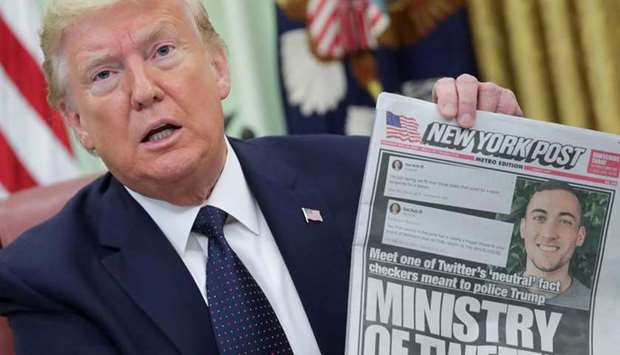The White House thumbed its nose at Twitter yesterday by reposting a President Donald Trump tweet that the social media giant had just taken the unprecedented step of hiding, because it violated the platform’s rules against “glorifying violence”.
The tit-for-tat marked a new escalation in the row between Twitter and Trump, who has more than 80mn followers and uses tweets daily to announce policies, attack opponents and comment on breaking news.
Twitter concluded that Trump fell afoul of its policies with a late-night tweet on violent anti-police protests in Minneapolis, when he called protesters “THUGS” and warned of military intervention.
“When the looting starts, the shooting starts,” Trump tweeted.
Twitter said his words were “glorifying violence” and hid the post, although readers could still click through to get access.
In response, the official White House account called Twitter’s bluff by retweeting the same post.
This time, Twitter responded by saying that while it violated its rules, the company “determined that it may be in the public’s interest for the Tweet to remain accessible”.
The White House later defended Trump’s tweet, saying: “The President did not glorify violence. He clearly condemned it.”
Trump’s social media director and Twitter feed manager, Dan Scavino, had his own response.
“Twitter is full of (expletive) – more and more people are beginning to get it,” he tweeted.
The latest spat came a day after Trump signed an executive order in the Oval Office seeking to transform the way social media companies are regulated.
The spat was first sparked by the social media giant’s decision to add a fact-check label to two of Trump’s tweets on mail-in voting, which were widely considered to be false.
In a major policy change for the company, Twitter told people to “get the facts” about voting by mail and provided links to news outlets often at odds with the president.
Yesterday Trump doubled down on his debunked claims, tweeting that “MAIL-IN VOTING WILL LEAD TO MASSIVE FRAUD AND ABUSE”.
Trump claims that the platform, where he dwarfs the presence of his Democratic rival Joe Biden for the November presidential election, is biased against him.
One immediate result of the blow-up between the social media-savvy president and the high-profile company has been to knock the coronavirus pandemic and recently reached toll of 100,000 dead Americans out of the headlines.
It also ties in with one of Trump’s major re-election themes: that despite being a billionaire White House incumbent with a Republican majority in the Senate, he is an outsider fighting a left-wing establishment.
Trump’s executive order seeks to remove social media platforms’ decades-long freedom from liability for content posted.
Instead of being allowed to self-regulate, this would treat the companies more like traditional publishers, open to government regulation and court challenges over false or harmful material.
Trump told reporters at the White House that he acted because big tech firms “have had unchecked power to censor, restrict, edit, shape, hide, alter any form of communication between private citizens or large public audiences”.
“We can’t let this continue to happen,” Trump said.
Ironically, his order could spur companies like Twitter to impose stricter lines for users, eventually curbing social media firebrands like Trump himself, who regularly goes online to insult people and support conspiracy theories.
How much will change in the near term is unclear, given the legal and political challenges facing Trump’s move.
Critics say Trump has no authority to regulate private Internet operators or change the law, known as Section 230, which backers say has allowed online platforms like Facebook and Twitter to flourish.
The American Civil Liberties Union (ACLU) called Trump’s order “a blatant and unconstitutional threat to punish social media companies that displease the president”.
Eric Goldman, director of the High-Tech Law Institute at Santa Clara University, said the order was “more about political theatre than about changing the law”.
The order “is not legally supportable – it flies in the face of more than 900 court decisions”, Goldman said.

Trump holds up a front page of the New York Post as he speaks to reporters while discussing an executive order on social media companies in the Oval Office of the White House.
